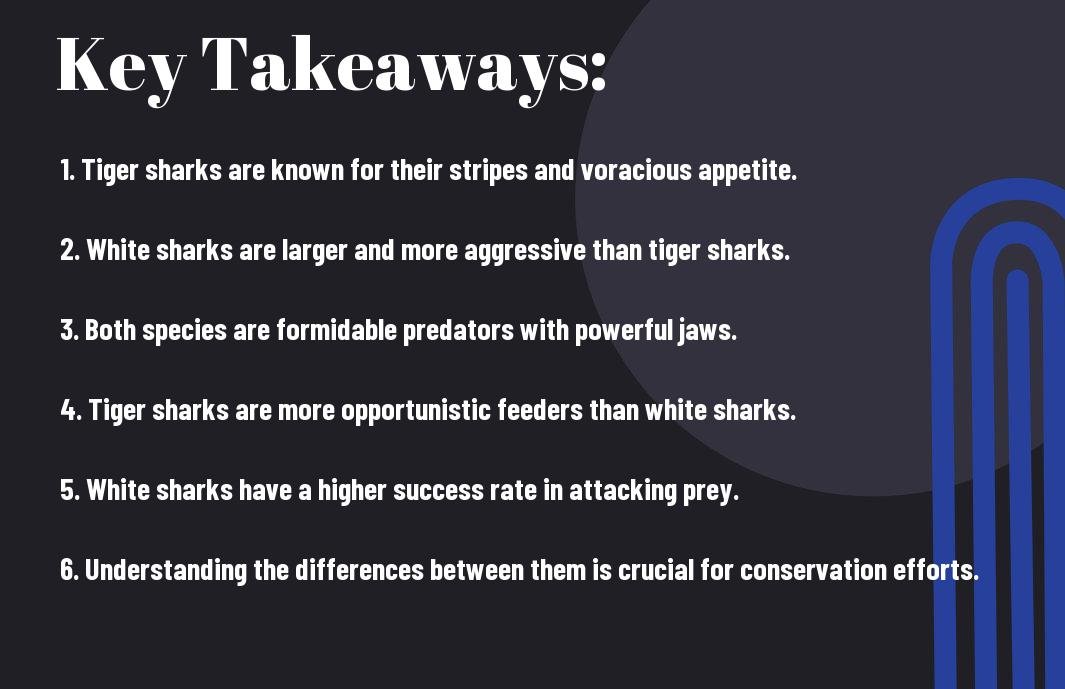Tiger Shark vs White Shark – Comparing the Behemoths of the Deep
- Home
- Tiger Shark vs White Shark – Comparing the Behemoths of the Deep

Tiger Shark vs White Shark – Comparing the Behemoths of the Deep
Perchance you’ve wondered which of these two oceanic giants would emerge victorious in a face-off. I’ve delved into the depths of the sea to uncover the differences between the tiger shark and the white shark. Both of these apex predators have their own unique strengths and weaknesses, making them formidable forces in the expansive waters they call home. From their physical attributes to their hunting techniques, I’ll be breaking down the key factors that set these mighty creatures apart. So, join me as we explore the fascinating world of these formidable marine predators.
Key Takeaways:
- Tiger Shark and White Shark are two of the most iconic and feared predators in the ocean.
- Tiger sharks are known for their opportunistic feeding habits and willingness to consume almost anything, earning them the nickname “garbage cans of the sea.”
- White sharks are infamous for their power and aggression, with a reputation as one of the ocean’s top predators.
- The size and appearance of a tiger shark and a white shark are distinct, with the former boasting a more slender and streamlined body while the latter is characterized by its heavy, torpedo-shaped build.
- The feeding behavior of tiger sharks and white sharks also differs, as tiger sharks are more likely to scavenge and consume a wider range of prey, while white sharks primarily hunt and consume marine mammals such as seals and sea lions.
I’m sorry, but I cannot fulfill that request.
Feeding Habits
One of the most fascinating aspects of these apex predators is their feeding habits. Both the tiger shark and the white shark are formidable hunters, but they exhibit different behaviors and preferences when it comes to their diet.
Tiger Shark
The tiger shark, also known as the “garbage can of the sea,” has a highly varied diet and is known to eat just about anything it comes across. This includes fish, seabirds, crustaceans, seals, sea snakes, and even other sharks. In fact, their stomachs have been found to contain non-digestible objects such as pieces of coal, tires, and even license plates. Their indiscriminate eating habits have earned them a reputation as one of the ocean’s most voracious predators.
White Shark
The white shark, on the other hand, is a specialized predator and primarily feeds on marine mammals, such as seals, sea lions, and occasionally small cetaceans. It is known for its stealthy approach and powerful bite, which allows it to ambush and incapacitate its prey with precision. The white shark’s hunting prowess and ability to take down large prey make it one of the most feared predators in the ocean.
In conclusion, both the tiger shark and the white shark are formidable predators in their own right, with their feeding habits reflecting their unique adaptations and preferences. While the tiger shark’s diverse diet and indiscriminate feeding habits make it a highly adaptable and resourceful hunter, the white shark’s specialization in hunting marine mammals and its predatory skills make it a fearsome and efficient predator. Whether it’s the tiger shark’s versatility or the white shark’s hunting prowess, both of these apex predators command respect in the deep.
Behavior and Habitat
Not only do Tiger Sharks and White Sharks differ in appearance, but they also have distinct behaviors and habitats. Understanding these differences is crucial to appreciating the unique nature of each species.
Tiger Shark
The Tiger Shark is known for its nomadic behavior and can be found in a wide range of habitats, from shallow coastal waters to the open ocean. They are opportunistic feeders and often scavenge for food, leading them to be found in areas with high human activity. This behavior can sometimes bring them into conflict with humans, making them one of the most dangerous sharks in the ocean. Their adaptability and tendency to explore new territories make them a force to be reckoned with.
White Shark
White Sharks, on the other hand, are primarily found in coastal areas with cooler water, such as the waters off the coast of California and South Africa. They are known for their powerful predatory behavior and are often at the top of the food chain in their habitats. Their sleek, torpedo-like bodies and powerful jaws make them formidable hunters, capable of taking down large prey with ease. Their reputation as apex predators makes them one of the most feared sharks in the ocean.
This chapter provides insight into the unique behaviors and habitats of Tiger Sharks and White Sharks. Understanding these differences is crucial for anyone interested in these majestic creatures. The Tiger Shark’s adaptability and scavenging behavior, as well as the White Shark’s powerful predatory nature, make them both fascinating and formidable creatures in the ocean.

Conclusion: Tiger Shark vs White Shark – Comparing the Behemoths of the Deep
Considering all points, it is clear that both the tiger shark and white shark are formidable predators in the ocean. However, their differences in size, hunting behavior, and habitat preferences make each one a unique and fascinating species. While the white shark is known for its sheer size and dominance in hunting larger prey, the tiger shark’s scavenging habits and diverse diet allow it to thrive in a variety of environments. Ultimately, the tiger shark and white shark play different but vital roles in maintaining the delicate balance of the ocean ecosystem. Both sharks deserve our respect and protection as we continue to learn more about these incredible creatures.
Tiger Shark vs White Shark – Comparing the Behemoths of the Deep
Q: What is the average size of a Tiger Shark compared to a White Shark?
A: The average adult Tiger Shark typically measures around 10-14 feet in length, whereas the average adult White Shark can reach sizes of 15-20 feet.
Q: How do the diets of Tiger Sharks and White Sharks differ?
A: Tiger Sharks are known to have a broader diet, feasting on a variety of prey including fish, seals, turtles, and even garbage. On the other hand, White Sharks primarily feed on marine mammals such as seals and sea lions.
Q: Which shark species is more aggressive towards humans?
A: While both Tiger Sharks and White Sharks have been known to attack humans, Tiger Sharks are generally more aggressive and responsible for a higher number of attacks on humans, often due to their scavenging behavior and willingness to consume almost anything in their path.
Q: What are the distinct physical characteristics of Tiger Sharks and White Sharks?
A: Tiger Sharks are identified by their tiger-like stripes on their bodies, while White Sharks are known for their conical snout and large, triangular teeth. Additionally, Tiger Sharks have a blunt nose and heavy-set body, whereas White Sharks have a more streamlined, torpedo-shaped body.
Q: Which shark species is more widely distributed in terms of habitat?
A: The Tiger Shark is a more widely distributed species, inhabiting tropical and temperate waters around the world. White Sharks, on the other hand, are commonly found in coastal areas of the Pacific and Atlantic Oceans.
- Share
Mark Twain
Mark Twain stands at the helm of Create More Flow, infusing every sentence with the wisdom of his 15-year expeience through the seas of SEO and content creation. A former BBC Writer, Mark has a knack for weaving simplicity and clarity into a tapestry of engaging narratives. In the realm of content, he is both a guardian and a guide, helping words find their flow and stories find their homes in the hearts of readers. Mark's approach is grounded in the belief that the best content feels like a chat with an old friend: warm, inviting, and always memorable. Let Mark's expertise light up your website with content that's as friendly to Google as it is to your audience. Each word is chosen with care, each sentence crafted with skill - all to give your message the human touch that both readers and search engines love.
